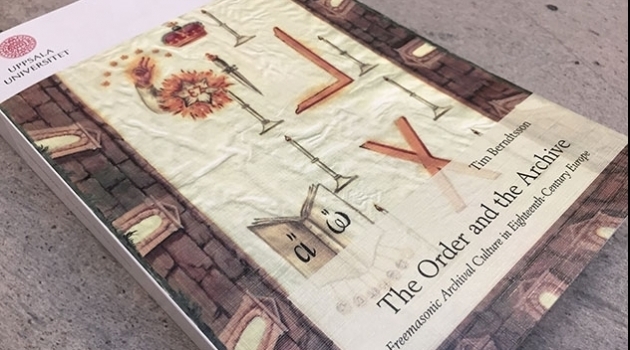Archives crucial for Freemasons’ identity
The Order of Freemasons’ meticulous archives are fundamental to their identity. The unique structure of the masonic archives reinforces the secrecy and mystique of the self-image that has been fashioned by the Order — and characterises it in the eyes of others. This is shown in a recent thesis from Uppsala University, which focuses on the Masons’ archives in the 18th and 19th centuries.
“On the other hand, there’s no longer as much secrecy as many people, both inside and outside the Order, believe. Digital versions of numerous printed works from the 18th and 19th centuries are now available online, and scholars have access to huge amounts of material in public research libraries and archives, especially in Germany and France.”
The speaker is Tim Berndtsson, a recent PhD graduate, whose thesis is about the archiving practices of Freemasonry in Europe. He spent five years reading documents and exploring archives in Copenhagen, Berlin and The Hague. He also visited the Archive and Library of the Swedish Order of Freemasons, which until recently were closed to external researchers.
Berndtsson’s research was motivated by his wish to investigate the nature of archiving practices in organised civic life and associations of the 18th century. Within a fairly short time, the masonic approach to archiving presented itself as a subject in its own right. The Masons established an advanced system of administrative autonomy, while the closed nature of Freemasonry also made their local associations (“lodges”) repositories of esoteric knowledge.
The European continental branch of Freemasonry (to which Sweden belongs), in particular, is distinguished by its comprehensive documentation and archiving tradition.
Powerful conspiracy theories
Berndtsson’s research focuses mainly on the latter half of the 18th century – a period when secrets of diverse kinds were a central feature of existence but the authorities, for their part, were deeply suspicious of all covert activities. This epoch culminated in the French Revolution (1789–99), which some sought to blame entirely on the Freemasons.
Photo: Agnes Kotka
“There are powerful conspiracy theories about them that have come to the fore at various times in history, depending on contemporary events. There’s no evidence for the demonising theories. It’s the very secrecy that creates them and has caused problems for the Masons, not only in the 18th and 19th centuries, but also from the world wars of the 20th century on.”
During the Second World War (1939–45), the Nazis systematically confiscated all the masonic material they could find. Once the war had ended, the Freemasons in France and Germany opted to deposit their collections in national research archives and generally open them up for serious scholarship. Given that the collections had already been brought out into the open, locking them away again was, they reasoned, no end in itself. This is the reason for the accessibility of these collections today, to members of the Order and outsiders alike.
Some of Berndtsson’s conclusions are as follows.
The Freemasons base their self-image and brand alike on all-inclusive archiving. Their thoroughness shows the conceptual importance of the archives in the 18th century, and also reflects how Freemasons in general see themselves.
“The Masons may be said to have created archives, but archives have also created the Masons. They’ve had clear rules about archiving. They’ve archived a great volume of different materials – from restaurant bills to initiation rituals – methodically and with meticulous care. They’ve managed to maintain the same procedures for a long time, and so been able to secure their own continuity, and build their own identity, over the centuries.”
Mixed archives
The Freemasons’ way of archiving demonstrates the diverse uses of archives through history.
Nowadays, many people associate archives with openness, but in the 18th century – especially for the Freemasons – secrecy was a more important component. Modern archive theory distinguishes between archives composed of administrative registers and those containing scholarly collections. The Masons’ archives were of both types, often mixed together and not infrequently housed in the same space. Administrative documents, such as a membership register, records of proceedings and descriptions of how to perform rituals for specific ranks, are stored on the same shelves in the same libraries as narratives about the history of the Knights Templar, alchemy, kabbalah and astrology.
“The elements of both administrative control and esoterica, which some have regarded as hocus-pocus and others a source of spiritual wisdom, have also resulted in the archives as such becoming the subject of fantasy. Ever since the 18th century, both conspiracy theories and novels have been created on the basis of notions about the Masons’ ‘secret archives’. These fantasies of hidden information and knowledge, in turn, have led to further books and other writings being produced – reinforcing even more the conception of Freemasonry as something exclusive and exceptional,” Berndtsson says.
Elin Bäckström
Publication
Berndtsson, T. (2020). The Order and the Archive: Freemasonic Archival Culture in Eighteenth-Century Europe. PhD thesis, Uppsala University, published in Acta Universitatis Upsaliensis.

